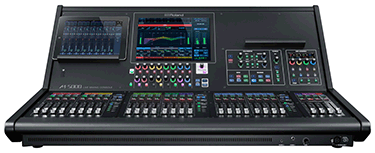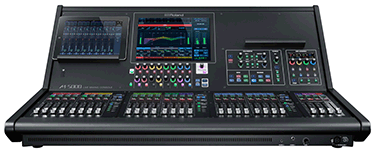The new Roland M-5000 will make its NAB debut to showcase its extensive broadcasting features. The M-5000 based on the O.H.R.C.A platform delivers freely definable audio paths, supporting multiple audio formats protocols, plus 96 kHz sound quality throughout the system. Because of the flexible architecture of the M-5000, the 128 audio paths can be freely defined including 5.1 surround mixing and monitoring, mix-minus busses, GPIO triggers, and delay important for broadcasting applications and OB Vans.

M-5000
OB vans today require lots of features in a small footprints and flexibility to handle a variety of remote broadcast events such as sports, concerts, newscasts, and awards ceremonies. Because the M-5000 can handle a variety of applications and has a flexible configuration it is the perfect digital audio console for broadcast.
The 5.1 surround functions can be accessed to change pan positions via the built-in touch panel or free downloaded remote control software. For 5.1-channel monitoring, individual delay, and alignment functions can be adjusted to speaker levels and delays. When using 5.1 surround mode, you can select output destinations and a simultaneous stereo downmix. Delays on every input and output with several different frame rates allow broadcasters the ability match the output.
The M-5000 features a mix-minus function, indispensable for recording and relay feeds, ideal for location or mobile broadcasts to remove a reporter/talent mic channels from the mix. M-5000’s flexible architecture allows you to freely assign the desired number of outputs for your Mix-Minus setup.
Using the flexibility of the O.H.R.C.A. platform found in the M-5000, a typical broadcast setup might include 84 mixing channels, 5.1 + LR output mix, six mono auxes, eight matrix, 5.1 +LR monitor setup, two downmixes, talkback, headphone monitoring, and talkback channel.
The M-5000 has two built-in REAC ports, plus two expansion card slots with seven expansion card options that include Dante, MADI, Waves SoundGrid, or more REAC ports, as well as future formats. The additional XI-expansion card options also include XI-SDI to mix 16-channels in/out of embedded audio off an SDI cable. It also includes XI-DVI for mixing up to 2-channels and the XI-SFP card for fiber optics and gigabit ethernet communications with up to 16-channels in/out ideal for broadcasting applications.
The back panel includes 16x16 analog I/O, 4x4 AES/EBU, a 16x16 USB audio interface, connection for control via an iPad connected or wireless, and control ports including footswitches, GPIO, RS-232C and MIDI. All of this capability enables the console to see up to 300 inputs and 296 outputs, all at 96kHz and even more at 48kHz.











